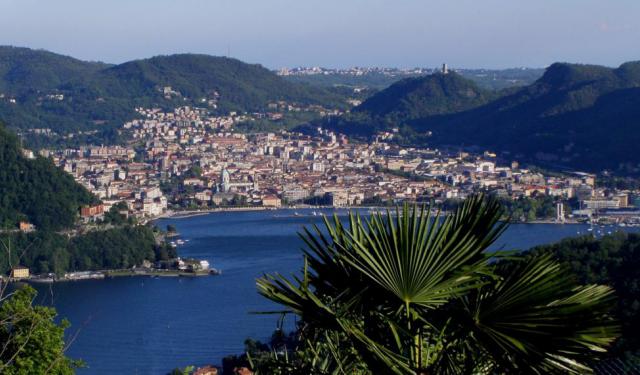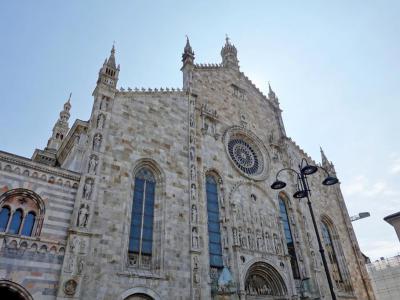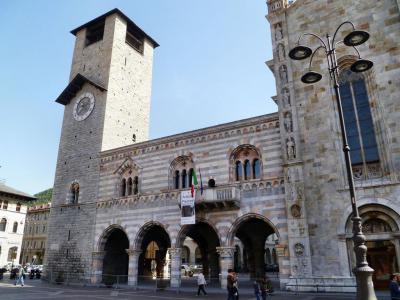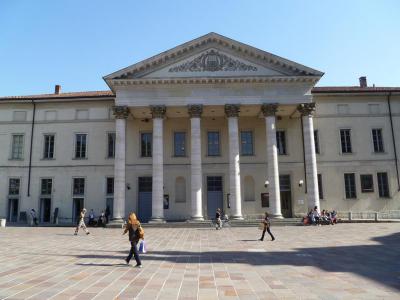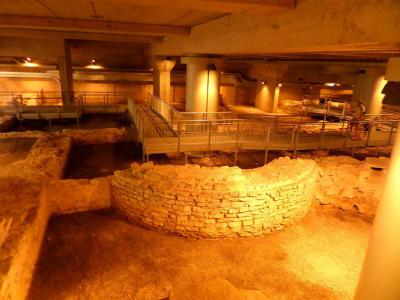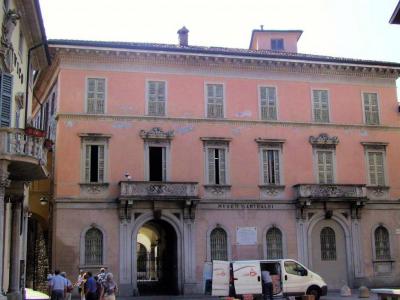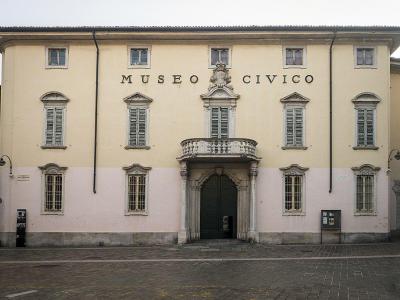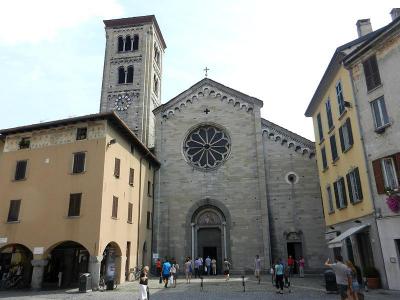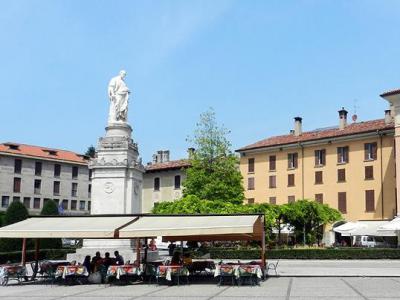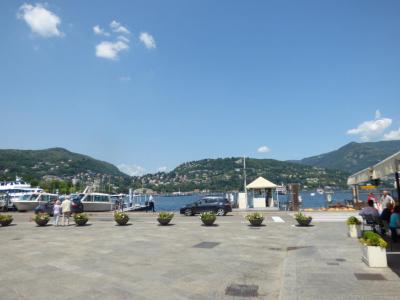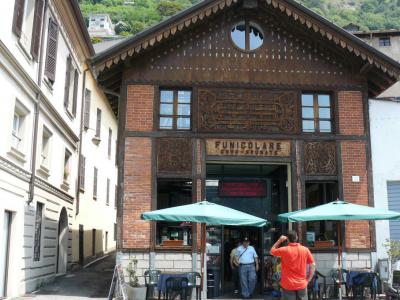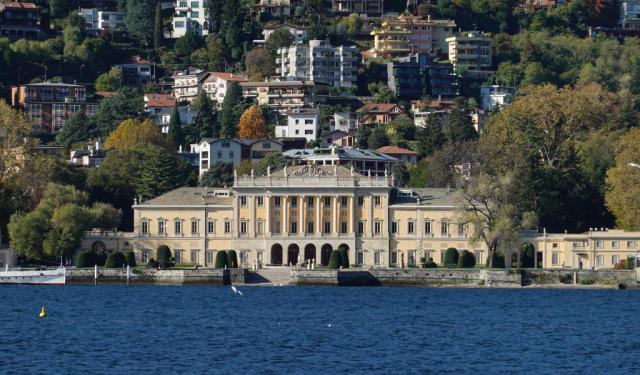Audio Guide: Como Introduction Walking Tour (Self Guided), Como
The Roman writer Pliny the Younger once wrote to his friend, “What is the news from Como, mine and your delight?” Como is a place of palaces, churches, gardens, temples, museums, and parks. Its nearness to the spectacular Lake Como and the Swiss and Italian Alps has made the area a traveler’s delight from the time of Pliny the Younger to the present day.
Pliny wasn’t its first fan, though. Long before Rome conquered the region, Celtic tribes had already settled along the lakeshore. Then came Julius Caesar in 59 BC. He drained swamps, laid out a Roman grid, and built walls-fragments of which still outline the old town today. The new settlement was called "New Comum", a name that eventually evolved into today’s Como.
History, of course, had no intention of leaving Como in peace. After Rome’s fall, the Lombards-and later the Carolingians-claimed it in turn, until the latter added it to their collection in 774. The Middle Ages were anything but quiet, as Como's status as a free commune interfered with the territorial and political ambitions of its bigger neighbor, Milan. Ultimately, the tension culminated in 1127 with the destruction of Como's fortifications, after a decade-long siege. Under Milan's influential Visconti family, the lakeside city blossomed economically, especially in silk production.
After Milan's influence waned, new rulers arrived in succession beginning in the 16th century: French invaders, Spanish governors, Austrian administrators, and, finally, Napoleon. By 1859, Garibaldi’s campaign had stitched Como into a unified Italy. The dictator Benito Mussolini had his day here, too-he was executed by partisans after passing through Como in 1945.
Through this long parade of empires and upheavals, certain landmarks anchored the city’s identity. Chief among them is the Cathedral-started in 1457 and finished in the 18th century-a blend of Gothic spires and Renaissance façades. Its face proudly adorns the image of Como’s famous sons, Pliny the Elder and Pliny the Younger, as if to remind visitors that there is a famous family reunion to behold.
And then there’s the funicular, a latecomer to the narrative but no less symbolic. Since 1894, it has carried locals and visitors from Como’s industrious streets to Brunate, the so-called “Balcony of the Alps,” where the lake spreads out like a silver map below.
So walk the streets-and don’t forget to write your friends about this lakeside delight, just like Pliny did. Como has always had plenty to write about.
Pliny wasn’t its first fan, though. Long before Rome conquered the region, Celtic tribes had already settled along the lakeshore. Then came Julius Caesar in 59 BC. He drained swamps, laid out a Roman grid, and built walls-fragments of which still outline the old town today. The new settlement was called "New Comum", a name that eventually evolved into today’s Como.
History, of course, had no intention of leaving Como in peace. After Rome’s fall, the Lombards-and later the Carolingians-claimed it in turn, until the latter added it to their collection in 774. The Middle Ages were anything but quiet, as Como's status as a free commune interfered with the territorial and political ambitions of its bigger neighbor, Milan. Ultimately, the tension culminated in 1127 with the destruction of Como's fortifications, after a decade-long siege. Under Milan's influential Visconti family, the lakeside city blossomed economically, especially in silk production.
After Milan's influence waned, new rulers arrived in succession beginning in the 16th century: French invaders, Spanish governors, Austrian administrators, and, finally, Napoleon. By 1859, Garibaldi’s campaign had stitched Como into a unified Italy. The dictator Benito Mussolini had his day here, too-he was executed by partisans after passing through Como in 1945.
Through this long parade of empires and upheavals, certain landmarks anchored the city’s identity. Chief among them is the Cathedral-started in 1457 and finished in the 18th century-a blend of Gothic spires and Renaissance façades. Its face proudly adorns the image of Como’s famous sons, Pliny the Elder and Pliny the Younger, as if to remind visitors that there is a famous family reunion to behold.
And then there’s the funicular, a latecomer to the narrative but no less symbolic. Since 1894, it has carried locals and visitors from Como’s industrious streets to Brunate, the so-called “Balcony of the Alps,” where the lake spreads out like a silver map below.
So walk the streets-and don’t forget to write your friends about this lakeside delight, just like Pliny did. Como has always had plenty to write about.
How it works: Download the app "GPSmyCity: Walks in 1K+ Cities" from Apple App Store or Google Play Store to your mobile phone or tablet. The app turns your mobile device into a personal tour guide and its built-in GPS navigation functions guide you from one tour stop to next. The app works offline, so no data plan is needed when traveling abroad.
Como Introduction Walking Tour Map
Guide Name: Como Introduction Walking Tour
Guide Location: Italy » Como (See other walking tours in Como)
Guide Type: Self-guided Walking Tour (Sightseeing)
# of Attractions: 10
Tour Duration: 2 Hour(s)
Travel Distance: 2.6 Km or 1.6 Miles
Author: DanaOffice
Sight(s) Featured in This Guide:
Guide Location: Italy » Como (See other walking tours in Como)
Guide Type: Self-guided Walking Tour (Sightseeing)
# of Attractions: 10
Tour Duration: 2 Hour(s)
Travel Distance: 2.6 Km or 1.6 Miles
Author: DanaOffice
Sight(s) Featured in This Guide:
- Duomo di Como (Como Cathedral)
- Broletto di Como (Old Town Hall)
- Teatro Sociale (Social Theater)
- Terme di Como Romana (Roman Baths of Como)
- Museo Storico Giuseppe Garibaldi (Giuseppe Garibaldi History Museum)
- Museo Archeologico Paolo Giovio (Paolo Giovio Archaeological Museum)
- Basilica di San Fedele (Basilica of Saint Fidelis)
- Statua di Alessandro Volta (Statue of Alessandro Volta)
- Piazza Cavour (Cavour Square)
- Como–Brunate Funicular and Village of Brunate
1) Duomo di Como (Como Cathedral) (must see)
Como Cathedral-officially Saint Mary of the Assumption-isn’t just another church planted in a square; it’s the city’s statement piece, four centuries in the making. Construction began back in 1396, on the ruins of a Romanesque church that had to make way for something bigger, bolder, and a little more ambitious. The front that greets you today, finished in the 15th century, is a stonemason’s masterpiece: a rose window, finely carved portals, and two very bookish locals-Pliny the Elder and Pliny the Younger-looking out from their glass cases. The last decoration came in 1770, when the dome rose above the skyline, sealing the building’s place as the final great Gothic cathedral of Italy-with a Renaissance and Baroque twist or two thrown in for good measure.
Step inside and the scale hits you first: soaring vaults, shafts of colored light from stained glass, and side chapels that pile on centuries of ornamentation. Here Gothic lines coexist with Renaissance elegance and Baroque spark. Look closely and you’ll find tapestries woven in Florence, Ferrara, and Antwerp, plus canvases by Bernardino Luini-Leonardo da Vinci’s disciple. Every corner has its own visual conversation between faith and artistry.
But this cathedral doesn’t live on grandeur alone. Local legend has slipped in a bit of whimsy at the north entrance-the “door of the frog.” A small carving from around 1400 shows a frog catching a butterfly. Harmless enough, until you hear the tale: during a catastrophic flood, the water stopped right at the frog’s level, sparing the city. Ever since, touching the frog is said to bring luck-and maybe keep the waters at bay.
So when you find yourself in Cathedral Square, don’t just admire the cathedral from afar. Climb the steps, peer up at the statues, duck inside to feel the layers of history overhead, and don’t forget to greet the frog.
Step inside and the scale hits you first: soaring vaults, shafts of colored light from stained glass, and side chapels that pile on centuries of ornamentation. Here Gothic lines coexist with Renaissance elegance and Baroque spark. Look closely and you’ll find tapestries woven in Florence, Ferrara, and Antwerp, plus canvases by Bernardino Luini-Leonardo da Vinci’s disciple. Every corner has its own visual conversation between faith and artistry.
But this cathedral doesn’t live on grandeur alone. Local legend has slipped in a bit of whimsy at the north entrance-the “door of the frog.” A small carving from around 1400 shows a frog catching a butterfly. Harmless enough, until you hear the tale: during a catastrophic flood, the water stopped right at the frog’s level, sparing the city. Ever since, touching the frog is said to bring luck-and maybe keep the waters at bay.
So when you find yourself in Cathedral Square, don’t just admire the cathedral from afar. Climb the steps, peer up at the statues, duck inside to feel the layers of history overhead, and don’t forget to greet the frog.
2) Broletto di Como (Old Town Hall)
The Old Town Hall-locals call it the Broletto-has been keeping Como’s civic life in order since 1215, when mayors still wore robes and citizens were summoned by the clang of a bell in its tower. The name comes from brolo, Latin for a walled garden, the sort of space where people once gathered to settle disputes or hear the latest decrees. Here, decisions that shaped the city were made beneath marble arches while the crowd pressed in below.
Take a look at the façade: not a uniform wall but stripes of white, gray, and pink marble from the nearby quarries, like the city’s own patchwork signature. It mixes Romanesque solidity with Gothic flourishes, and later centuries layered on Renaissance touches too. Originally, a grand tower stood tall beside it, a symbol of civic pride; now only fragments remain, but you can still sense its presence.
Time, as always, reshuffled the building’s role. Once the neighboring Cathedral began expanding, the Town Hall had to bend to its grandeur. It later doubled as a theater and even stored the city’s archives. By the 20th century, restorers stripped back the alterations, coaxing it closer to its medieval outline.
Today, wedged between Cathedral Square and the great church, the Town Hall has found a new purpose-not in councils and proclamations but in art shows, exhibitions, and concerts. If the Cathedral is Como’s soul, this former town house provides the civic heartbeat: striped marble, wide arches, and a history that shows it has never been just for admiring but always for living the moment.
Take a look at the façade: not a uniform wall but stripes of white, gray, and pink marble from the nearby quarries, like the city’s own patchwork signature. It mixes Romanesque solidity with Gothic flourishes, and later centuries layered on Renaissance touches too. Originally, a grand tower stood tall beside it, a symbol of civic pride; now only fragments remain, but you can still sense its presence.
Time, as always, reshuffled the building’s role. Once the neighboring Cathedral began expanding, the Town Hall had to bend to its grandeur. It later doubled as a theater and even stored the city’s archives. By the 20th century, restorers stripped back the alterations, coaxing it closer to its medieval outline.
Today, wedged between Cathedral Square and the great church, the Town Hall has found a new purpose-not in councils and proclamations but in art shows, exhibitions, and concerts. If the Cathedral is Como’s soul, this former town house provides the civic heartbeat: striped marble, wide arches, and a history that shows it has never been just for admiring but always for living the moment.
3) Teatro Sociale (Social Theater)
The Social Theater of Como has been setting the stage for culture since 1813, when the city’s nobility decided the old playhouse of 1765 had outlived its sparkle. They picked the site of the ruined medieval Round Tower, handed the project to architect Giuseppe Cusi, and-there you go-a neoclassical gem rose, its façade tipping a respectful nod to Milan’s La Scala theater. The curtain went up with the opera Adriano in Siria, and Como had its new cultural centerpiece.
From there, the theater grew in ambition and in size. By 1854, new boxes were squeezed in, bringing the count to 98, though even that wasn’t enough. By the early 1900s, the audience had outgrown the house again, a testament to Como’s appetite for art. But the theater never lost its pull: Paganini electrified audiences here with his violin skills in 1823, Liszt piano dazzled in 1837, and generations of music lovers followed suit. Step inside, and the symphony begins before the first note: a cello-shaped auditorium dressed in red velvet, a ceiling adorned with muses descending from Olympus, and a stage curtain showing the fiery death of Pliny the Elder – only for him to get brought back to life on the nearby cathedral.
And then there’s the Arena, the open-air stage that roared back to life in 2013 with Carmina Burana after decades of silence. Today, the theater keeps its double life: heritage on the outside, living art on the inside. Its program swings from opera and classical concerts to contemporary dance and family shows, and every July the Como City of Music Festival takes over the streets, turning the whole town into a stage.
For those who step inside, it offers not only ornate décor but also a living pulse of creativity that has kept audiences returning for over two hundred years.
From there, the theater grew in ambition and in size. By 1854, new boxes were squeezed in, bringing the count to 98, though even that wasn’t enough. By the early 1900s, the audience had outgrown the house again, a testament to Como’s appetite for art. But the theater never lost its pull: Paganini electrified audiences here with his violin skills in 1823, Liszt piano dazzled in 1837, and generations of music lovers followed suit. Step inside, and the symphony begins before the first note: a cello-shaped auditorium dressed in red velvet, a ceiling adorned with muses descending from Olympus, and a stage curtain showing the fiery death of Pliny the Elder – only for him to get brought back to life on the nearby cathedral.
And then there’s the Arena, the open-air stage that roared back to life in 2013 with Carmina Burana after decades of silence. Today, the theater keeps its double life: heritage on the outside, living art on the inside. Its program swings from opera and classical concerts to contemporary dance and family shows, and every July the Como City of Music Festival takes over the streets, turning the whole town into a stage.
For those who step inside, it offers not only ornate décor but also a living pulse of creativity that has kept audiences returning for over two hundred years.
4) Terme di Como Romana (Roman Baths of Como)
Beneath the polished surface of modern Como lies a surprise Pliny the Younger would never have imagined: his 1st-century gift to the city, a set of Roman baths, now lodged under an underground car park. The story began in the 1970s, when construction workers broke into more than just rock and soil-they stumbled onto eight ancient rooms spread across 1,500 square meters. Heated chambers, pools, and lounging spaces emerged from the dirt, echoing a time when bathing was as much about politics and gossip as it was about hygiene.
The plot thickened in the early 2000s, when archaeologists returned to the site and unearthed ten more rooms from the 2nd century AD. Arranged around a central courtyard, their exact purpose remains a mystery, though the discovery confirmed Como’s Roman incarnation-Novum Comum-was thriving, ambitious, and more cosmopolitan than its lakeside calm suggests today.
Now, instead of steam and chatter, visitors find quiet panels and artifacts beneath the Social Theater’s modern parking structure. Displays explain the ingenious hypocaust heating system and the water circulation that once powered daily rituals of relaxation. Though only fragments survive, there’s a peculiar magic to standing here-caught between exhaust fumes above and Roman engineering below-seeing how one city layer rests on another.
For anyone curious about Como’s deeper story, the baths provide a compact but powerful reminder: this elegant town wasn’t always about silk, villas, and alpine views. Two thousand years ago, it was about hot water, stone walls, and the simple Roman belief that civilization thrived where people gathered, soaked, and talked.
The plot thickened in the early 2000s, when archaeologists returned to the site and unearthed ten more rooms from the 2nd century AD. Arranged around a central courtyard, their exact purpose remains a mystery, though the discovery confirmed Como’s Roman incarnation-Novum Comum-was thriving, ambitious, and more cosmopolitan than its lakeside calm suggests today.
Now, instead of steam and chatter, visitors find quiet panels and artifacts beneath the Social Theater’s modern parking structure. Displays explain the ingenious hypocaust heating system and the water circulation that once powered daily rituals of relaxation. Though only fragments survive, there’s a peculiar magic to standing here-caught between exhaust fumes above and Roman engineering below-seeing how one city layer rests on another.
For anyone curious about Como’s deeper story, the baths provide a compact but powerful reminder: this elegant town wasn’t always about silk, villas, and alpine views. Two thousand years ago, it was about hot water, stone walls, and the simple Roman belief that civilization thrived where people gathered, soaked, and talked.
5) Museo Storico Giuseppe Garibaldi (Giuseppe Garibaldi History Museum)
Step into the Olginati Palace, a 15th-century residence that now hosts a museum with a story as dramatic as the man it celebrates-Giuseppe Garibaldi. Here, walls don’t just echo with art, they echo with battle cries. In May 1859, Garibaldi and his ragtag “Hunters of the Alps” clashed with Austrian forces at Saint Fermo, just outside Como. Fourteen of his men fell, but the Austrians lost the field, and Garibaldi’s victory gave momentum to the unification of Italy. Relics from that day-uniforms, weapons, and documents-now sit just a few rooms away, making the past feel very close.
The museum opened in 1932, on the 50th anniversary of Garibaldi’s death, and quickly became a cornerstone of Como’s civic identity. Connected by covered walkways to the Archaeological Museum next door, it forms part of the city’s cultural backbone. Its setting alone-a Renaissance palace lovingly restored-adds significance before you even glimpse the exhibits.
Inside, you’ll find two threads woven together. One leads through the Italian Unification, tracing Garibaldi’s campaigns, the rebellions, and the wars of independence that reshaped Italy. The other broadens the scope to Como itself: period rooms draped in textiles, furniture, and objects from the 17th to the 20th centuries recreate the rhythm of everyday life.
Just like Garibaldi fought for the truth, come and hunt down your favorite pieces of this historical puzzle. The choice will not be easy, though. Few places capture so clearly the sense of a city negotiating both its place in history and the drama of a nation being born.
The museum opened in 1932, on the 50th anniversary of Garibaldi’s death, and quickly became a cornerstone of Como’s civic identity. Connected by covered walkways to the Archaeological Museum next door, it forms part of the city’s cultural backbone. Its setting alone-a Renaissance palace lovingly restored-adds significance before you even glimpse the exhibits.
Inside, you’ll find two threads woven together. One leads through the Italian Unification, tracing Garibaldi’s campaigns, the rebellions, and the wars of independence that reshaped Italy. The other broadens the scope to Como itself: period rooms draped in textiles, furniture, and objects from the 17th to the 20th centuries recreate the rhythm of everyday life.
Just like Garibaldi fought for the truth, come and hunt down your favorite pieces of this historical puzzle. The choice will not be easy, though. Few places capture so clearly the sense of a city negotiating both its place in history and the drama of a nation being born.
6) Museo Archeologico Paolo Giovio (Paolo Giovio Archaeological Museum)
Just like its neighbor, the Paolo Giovio Archeological Museum collects pieces of legacy, but with a different twist. Since 1894, the exhibits have lived in the Giovio Palace, once home to one of Como’s most prominent families. The building itself carries centuries of history in its stones: medieval roots reshaped in the 16th century by Benedetto Giovio, then touched up again in the 18th with grand windows, a new stairway, and even a garden shrine. An elevated walkway links it with the Olginati Palace next door, tying two civic museums together under one cultural roofline.
The palace doesn’t hide its Renaissance flair either. Inside, frescoes line the halls-Rodriguez in the Perrone Hall, Coduri in the Barelli Hall, Ronchelli in the aptly named Hall of the Wedding-each room still wearing its painted finery. Over the 20th century, the museum grew into a cultural crossroads: first with a Historical Museum in 1932, later an Art Gallery in 1989.
But the real draw? The timeline it unfolds. From prehistoric tools found around Lake Como to mosaics, inscriptions, and ceramics from the Roman colony of Novum Comum, the galleries let you piece together daily life in the city across two millennia. Add Lombard relics, medieval finds, and a trove of Egyptian, Greek, and Great Greece (meaning a group of ancient Greek cities along the coast of southern Italy) artifacts, and you’ve got a museum that stretches far beyond Como’s own borders.
Panels update the story with each new excavation, while a library waits for those who want to dive even deeper. For travelers, the reward is twofold: the thrill of ancient history and the atmosphere of a Renaissance palace, sitting quietly in the middle of Como’s old town.
The palace doesn’t hide its Renaissance flair either. Inside, frescoes line the halls-Rodriguez in the Perrone Hall, Coduri in the Barelli Hall, Ronchelli in the aptly named Hall of the Wedding-each room still wearing its painted finery. Over the 20th century, the museum grew into a cultural crossroads: first with a Historical Museum in 1932, later an Art Gallery in 1989.
But the real draw? The timeline it unfolds. From prehistoric tools found around Lake Como to mosaics, inscriptions, and ceramics from the Roman colony of Novum Comum, the galleries let you piece together daily life in the city across two millennia. Add Lombard relics, medieval finds, and a trove of Egyptian, Greek, and Great Greece (meaning a group of ancient Greek cities along the coast of southern Italy) artifacts, and you’ve got a museum that stretches far beyond Como’s own borders.
Panels update the story with each new excavation, while a library waits for those who want to dive even deeper. For travelers, the reward is twofold: the thrill of ancient history and the atmosphere of a Renaissance palace, sitting quietly in the middle of Como’s old town.
7) Basilica di San Fedele (Basilica of Saint Fidelis) (must see)
The Basilica of Saint Fidelis holds pride of place in its namesake square, right in Como’s historic center. It honors the city’s patron saint, a soldier-turned-martyr who, along with Carpophorus and Exanthus, met his end during the persecutions of Emperor Diocletian. The ground beneath your feet has seen worship for well over a millennium: the first church here, dedicated to Saint Euphemia, dates back to the early medieval centuries. The current structure took shape in 1120, and while its bones are Romanesque, later centuries couldn’t resist leaving their mark-Baroque touches crept in, and in 1914 Antonio Giussani refashioned the façade into the Neo-Romanesque form you see today. Even the bell tower has had several lives, rebuilt after earthquakes and finally replaced at the start of the 20th century.
Get dragged inside, and the basilica tells its story in layers. Its Latin Cross plan opens into three naves and three apses, with a dome and ambulatory framing walls alive with art. Medieval murals still peek from the shadows, while 1623 frescoes blaze across the Chapel of the Crucifix with visions of God, Christ, and hosts of saints and angels. The Passion is captured in Carlo Carloni’s canvases along the south aisle, while the north is brightened by 17th-century frescoes of the Virgin Mary and the Magi. And tucked in another chapel, De Magistris’ 1504 altarpiece of the Madonna with Child quietly radiates Renaissance devotion.
Given that beneath its dome lie the relics of Saint Fidelis himself-the church cradles his soul and invites everyone for a prayer, even if it is a short one. Como has a lot to dig in to, after all.
Get dragged inside, and the basilica tells its story in layers. Its Latin Cross plan opens into three naves and three apses, with a dome and ambulatory framing walls alive with art. Medieval murals still peek from the shadows, while 1623 frescoes blaze across the Chapel of the Crucifix with visions of God, Christ, and hosts of saints and angels. The Passion is captured in Carlo Carloni’s canvases along the south aisle, while the north is brightened by 17th-century frescoes of the Virgin Mary and the Magi. And tucked in another chapel, De Magistris’ 1504 altarpiece of the Madonna with Child quietly radiates Renaissance devotion.
Given that beneath its dome lie the relics of Saint Fidelis himself-the church cradles his soul and invites everyone for a prayer, even if it is a short one. Como has a lot to dig in to, after all.
8) Statua di Alessandro Volta (Statue of Alessandro Volta)
Alessandro Volta’s tale begins not with lightning bolts or grand laboratories, but with frogs. In the late 1700s, Luigi Galvani was busy poking at frog legs, convinced their twitching proved that animals themselves generated electricity. Volta, ever the contrarian son of Como, thought otherwise. He suspected the spark came from the metals, not the meat. To prove it, he stacked discs of copper and zinc, separated by brine-soaked cloth. The result? The voltaic pile-the world’s first true battery, born in 1800. Suddenly, electricity wasn’t just a curiosity, it was chemistry harnessed-and the field of electrochemistry took off. Fame followed, but Volta himself preferred quiet country life, where he died in 1827 at the age of 82.
Como wasted little time in immortalizing him. By 1838, a monument rose in Volta Square. Sculptor Pompeo Marchesi cast him in Roman dignity, toga draped just so, a book in one hand and his battery under the other. The pedestal bears inscriptions of his achievements. A pair of bronze plaques added later mark the centenary of the battery, reminding passersby that modern science was sparked, quite literally, here.
Today, the statue is less background ornament than cornerstone. It anchors a lively square of cafés and chatter, linking everyday Como to its most famous native son. Stand before it and you’re in the company of a man whose curiosity rewired the world.
Como wasted little time in immortalizing him. By 1838, a monument rose in Volta Square. Sculptor Pompeo Marchesi cast him in Roman dignity, toga draped just so, a book in one hand and his battery under the other. The pedestal bears inscriptions of his achievements. A pair of bronze plaques added later mark the centenary of the battery, reminding passersby that modern science was sparked, quite literally, here.
Today, the statue is less background ornament than cornerstone. It anchors a lively square of cafés and chatter, linking everyday Como to its most famous native son. Stand before it and you’re in the company of a man whose curiosity rewired the world.
9) Piazza Cavour (Cavour Square) (must see)
Cavour Square sits where Como’s old town fades into the lakefront-a stage that’s seen more reinventions than some opera houses. In the Middle Ages, this patch of ground was little more than a swamp. Fast forward to the 19th century, when Como decided its waterfront needed a facelift, and suddenly the marsh became a plaza worthy of national pride. They named it after Camillo Benso, Count of Cavour, one of the masterminds behind Italian unification-joining the other illustrious Como personalities.
From here, the lake does its best impression of a painting. Boats slide across the water, the hills rise up green and steep, and if you squint, you can spot the Volta Lighthouse on the far ridge. To the west, the 1846 Hotel Metropole Suisse presides with its quiet confidence, while the east side offers the sort of cafés, trattorias, and gelato counters that can delay even the most determined sightseeing schedule. Street performers often add their own soundtrack, just in case the place wasn’t lively enough.
The square also knows how to party. Each June, swing bands bring back the 1930s and ’40s for the Swing Crash Festival. December transforms it into a Christmas market, all lights and wooden stalls. And year-round, it serves as a launchpad: ferries to the lake towns, the cathedral a short stroll away, the funicular to Brunate just along the promenade.
As far as plazas are concerned, they are a meeting point. The best Count of Cavour role play is to reunite with your friends and close ones by breathing in the forever changing atmosphere of this square . Beware of the seagulls, for they might steal your gelato.
From here, the lake does its best impression of a painting. Boats slide across the water, the hills rise up green and steep, and if you squint, you can spot the Volta Lighthouse on the far ridge. To the west, the 1846 Hotel Metropole Suisse presides with its quiet confidence, while the east side offers the sort of cafés, trattorias, and gelato counters that can delay even the most determined sightseeing schedule. Street performers often add their own soundtrack, just in case the place wasn’t lively enough.
The square also knows how to party. Each June, swing bands bring back the 1930s and ’40s for the Swing Crash Festival. December transforms it into a Christmas market, all lights and wooden stalls. And year-round, it serves as a launchpad: ferries to the lake towns, the cathedral a short stroll away, the funicular to Brunate just along the promenade.
As far as plazas are concerned, they are a meeting point. The best Count of Cavour role play is to reunite with your friends and close ones by breathing in the forever changing atmosphere of this square . Beware of the seagulls, for they might steal your gelato.
10) Como–Brunate Funicular and Village of Brunate (must see)
Hop aboard the Como–Brunate Funicular and in seven minutes you’ll swap lakefront bustle for mountaintop calm. The line has been hauling people up and down since 1894-steam at first, electricity soon after, and since 2011, sleek modern cars that carry eighty at a time. The ride starts beside Como’s quays, ducks through a tunnel, then bursts out into open air with views that make you forget you’re on public transport. Boats glide on the lake below, and the Alps stretch like a painted backdrop in the distance.
At the top sits Brunate, a village of fewer than two thousand residents but with a pedigree far grander than its size. Once a retreat for Como’s wealthy, it’s still lined with Liberty-style villas from the turn of the 20th century. The 14th-century Church of Saint Andrew watches over the main square, its Romanesque tower chiming over cafés, pizzerias, and narrow streets that slope toward viewpoints at every turn.
And then there’s the Volta Lighthouse-built in 1927 to honor Como’s most famous son, Alessandro Volta, inventor of the electric battery. From its ridge above Brunate, the view sweeps across the lake, the Alps, and on the clearest days, all the way to the Apennines. Locals even share a legend about Kangucavallo, a kindly half-horse, half-kangaroo who once carried a weary family up to the lighthouse and now appears only to pure hearts wandering the woods.
As an unofficial time machine, the funicular stitches together personalities, folklore and breathtaking landscapes. Kangucavallo is ready to take your photos, just be kind to him.
At the top sits Brunate, a village of fewer than two thousand residents but with a pedigree far grander than its size. Once a retreat for Como’s wealthy, it’s still lined with Liberty-style villas from the turn of the 20th century. The 14th-century Church of Saint Andrew watches over the main square, its Romanesque tower chiming over cafés, pizzerias, and narrow streets that slope toward viewpoints at every turn.
And then there’s the Volta Lighthouse-built in 1927 to honor Como’s most famous son, Alessandro Volta, inventor of the electric battery. From its ridge above Brunate, the view sweeps across the lake, the Alps, and on the clearest days, all the way to the Apennines. Locals even share a legend about Kangucavallo, a kindly half-horse, half-kangaroo who once carried a weary family up to the lighthouse and now appears only to pure hearts wandering the woods.
As an unofficial time machine, the funicular stitches together personalities, folklore and breathtaking landscapes. Kangucavallo is ready to take your photos, just be kind to him.
Walking Tours in Como, Italy
Create Your Own Walk in Como
Creating your own self-guided walk in Como is easy and fun. Choose the city attractions that you want to see and a walk route map will be created just for you. You can even set your hotel as the start point of the walk.
Como Lakeshore Walking Tour
English novelist Mary Shelley declared visitors to Italy are in danger of becoming: "enjoyers of the beauties of nature, the elegance of art, the delights of climate, the recollections of the past, and the pleasures of society." All this she found on the shores of Lake Como. From Roman writer Pliny the Younger onward, visitors and natives of Como would have agreed.
The alpine lake is... view more
Tour Duration: 1 Hour(s)
Travel Distance: 2.1 Km or 1.3 Miles
The alpine lake is... view more
Tour Duration: 1 Hour(s)
Travel Distance: 2.1 Km or 1.3 Miles
The Most Popular Cities
/ view all
